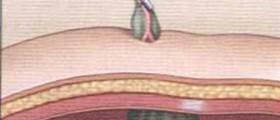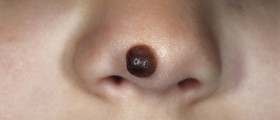Birthmarks are pretty common in people all around the world. They can be of two main kinds: pigment or vascular.
Pigmented birthmarks
As the name suggests these birthmarks are distinct because of an area of altered pigmentation from the surrounding skin. Moles are the most common kind of pigmented birthmarks that people come across. The size and color of different moles can vary but the most common presentation is that of a small, round, brown spot.
It is recommended that any moles which itch a lot, bleed, or change appearance be inspected by the doctor to rule out anything serious.
Less common kinds of pigmented birthmarks include café-au-lait spots and Mongolian spots.

Vascular birthmarks
The collection of arteries, veins, and capillaries running through our bodies is collectively called the vascular system. Some of these blood vessels can get clumped together and be visible through the skin. That is what is referred to as a vascular birthmark.
It is estimated that 1 in every 10 babies is born with a vascular birthmark.
Some of the different kinds of vascular birthmarks are called as salmon patches, hemangiomas, and port wine stains. Vascular birthmarks are indicative of the underlying blood vessels and are usually reddish, bluish in color. They can also throb and pulsate.
Birthmark Removal
Most people get their birthmarks removed because of cosmetic reasons. There may also be a medical cause for getting birthmarks removed. The decision to remove a birthmark is taken after a dermatologic examination.
If the dermatologist or the affected individual notices any change in size, appearance, or behavior of the birthmark then its removal may be recommended.
Method of removal of birthmarks
The most common method of birthmark removal is through a surgical excision. Depending upon the kind of birthmark, the procedure can be relatively simple. The doctor will administer local anesthesia to numb the area, remove the birthmark, and then stitch up the wound.
Whether a scar remains after the birthmark has been removed or not depends on the kind of birthmark, its size, as well as how deep into the skin it was penetrating. Most superficial moles heal without a trace but the deeper ones almost always leave a slight trace behind.
The removal of vascular birthmarks is slightly more complex than pigmented ones. In a large majority of the cases, small vascular birthmarks seen in children will resolve themselves. Most doctors will advise waiting and observing for some time before operating on a vascular birthmark. If, however, the birthmark does not resolve on its own or grows in size then it has to be removed.
Care has to be taken to ensure that adequate measures are taken to control the bleeding in case of a vascular birthmark removal. Lasers, cryotherapy, or electro-surgery are options which may be preferred to the regular scalpel in such cases because of the automatic bleeding control they provide.
A general surgeon can do the removal of a birthmark but if the area of the body being operated on is cosmetically important, then it is highly recommended to refer a plastic surgeon as well.
- www.ncbi.nlm.nih.gov/pubmed/18236823
- Photo courtesy of SteadyHealth
















